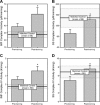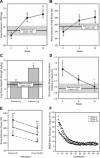Novel, high-intensity exercise prescription improves muscle mass, mitochondrial function, and physical capacity in individuals with Parkinson's disease
- PMID: 24408997
- PMCID: PMC4073951
- DOI: 10.1152/japplphysiol.01277.2013
Novel, high-intensity exercise prescription improves muscle mass, mitochondrial function, and physical capacity in individuals with Parkinson's disease
Abstract
We conducted, in persons with Parkinson's disease (PD), a thorough assessment of neuromotor function and performance in conjunction with phenotypic analyses of skeletal muscle tissue, and further tested the adaptability of PD muscle to high-intensity exercise training. Fifteen participants with PD (Hoehn and Yahr stage 2-3) completed 16 wk of high-intensity exercise training designed to simultaneously challenge strength, power, endurance, balance, and mobility function. Skeletal muscle adaptations (P < 0.05) to exercise training in PD included myofiber hypertrophy (type I: +14%, type II: +36%), shift to less fatigable myofiber type profile, and increased mitochondrial complex activity in both subsarcolemmal and intermyofibrillar fractions (I: +45-56%, IV: +39-54%). These adaptations were accompanied by a host of functional and clinical improvements (P < 0.05): total body strength (+30-56%); leg power (+42%); single leg balance (+34%); sit-to-stand motor unit activation requirement (-30%); 6-min walk (+43 m), Parkinson's Disease Quality of Life Scale (PDQ-39, -7.8pts); Unified Parkinson's Disease Rating Scale (UPDRS) total (-5.7 pts) and motor (-2.7 pts); and fatigue severity (-17%). Additionally, PD subjects in the pretraining state were compared with a group of matched, non-PD controls (CON; did not exercise). A combined assessment of muscle tissue phenotype and neuromuscular function revealed a higher distribution and larger cross-sectional area of type I myofibers and greater type II myofiber size heterogeneity in PD vs. CON (P < 0.05). In conclusion, persons with moderately advanced PD adapt to high-intensity exercise training with favorable changes in skeletal muscle at the cellular and subcellular levels that are associated with improvements in motor function, physical capacity, and fatigue perception.
Keywords: Parkinson's disease; high-intensity exercise; mitochondria; muscle hypertrophy; resistance training.
Figures



Similar articles
-
High-intensity interval versus moderate-intensity continuous cycling training in Parkinson's disease: a randomized trial.J Appl Physiol (1985). 2024 Sep 1;137(3):603-615. doi: 10.1152/japplphysiol.00219.2024. Epub 2024 Jul 15. J Appl Physiol (1985). 2024. PMID: 39008618 Clinical Trial.
-
Power vs strength training to improve muscular strength, power, balance and functional movement in individuals diagnosed with Parkinson's disease.Exp Gerontol. 2019 Dec;128:110740. doi: 10.1016/j.exger.2019.110740. Epub 2019 Oct 21. Exp Gerontol. 2019. PMID: 31648006 Clinical Trial.
-
Effect of physical therapy on the isokinetic performance of knee flexors and extensors and functional balance in older adults with Parkinson's disease, according to severity.J Bodyw Mov Ther. 2024 Oct;40:465-471. doi: 10.1016/j.jbmt.2023.02.001. Epub 2023 Feb 7. J Bodyw Mov Ther. 2024. PMID: 39593627
-
Current Perspectives on Aerobic Exercise in People with Parkinson's Disease.Neurotherapeutics. 2020 Oct;17(4):1418-1433. doi: 10.1007/s13311-020-00904-8. Neurotherapeutics. 2020. PMID: 32808252 Free PMC article. Review.
-
The Effect of Different Exercise Modes on Domain-Specific Cognitive Function in Patients Suffering from Parkinson's Disease: A Systematic Review of Randomized Controlled Trials.J Parkinsons Dis. 2019;9(1):73-95. doi: 10.3233/JPD-181484. J Parkinsons Dis. 2019. PMID: 30741688
Cited by
-
Fatigue in Parkinson's disease: report from a mutidisciplinary symposium.NPJ Parkinsons Dis. 2016;2:15025-. doi: 10.1038/npjparkd.2015.25. Epub 2016 Jan 14. NPJ Parkinsons Dis. 2016. PMID: 27239558 Free PMC article.
-
Impaired skeletal muscle health in Parkinsonian syndromes: clinical implications, mechanisms and potential treatments.J Cachexia Sarcopenia Muscle. 2023 Oct;14(5):1987-2002. doi: 10.1002/jcsm.13312. Epub 2023 Aug 13. J Cachexia Sarcopenia Muscle. 2023. PMID: 37574254 Free PMC article. Review.
-
Exercise and Parkinson's Disease.Adv Exp Med Biol. 2020;1228:289-301. doi: 10.1007/978-981-15-1792-1_19. Adv Exp Med Biol. 2020. PMID: 32342465 Review.
-
Skeletal muscle mitochondrial health and spinal cord injury.World J Orthop. 2016 Oct 18;7(10):628-637. doi: 10.5312/wjo.v7.i10.628. eCollection 2016 Oct 18. World J Orthop. 2016. PMID: 27795944 Free PMC article. Review.
-
Effects of Exercise Training on Muscle Quality in Older Individuals: A Systematic Scoping Review with Meta-Analyses.Sports Med Open. 2023 Jun 6;9(1):41. doi: 10.1186/s40798-023-00585-5. Sports Med Open. 2023. PMID: 37278947 Free PMC article.
References
-
- Allen DG, Lamb GD, Westerblad H. Skeletal muscle fatigue: cellular mechanisms. Physiol Reviews 88: 287–332, 2008 - PubMed
-
- Allen NE, Sherrington C, Canning CG, Fung VS. Reduced muscle power is associated with slower walking velocity and falls in people with Parkinson's disease. Parkinsonism Relat Disord 16: 261–264, 2010 - PubMed
-
- Allen NE, Sherrington C, Paul SS, Canning CG. Balance and falls in Parkinson's disease: a meta-analysis of the effect of exercise and motor training. Mov Disord 26: 1605–1615, 2011 - PubMed
-
- Archer T, Fredriksson A, Johansson B. Exercise alleviates Parkinsonism: clinical and laboratory evidence. Acta Neurol Scand 123: 73–84, 2011 - PubMed
-
- Atherton PJ, Babraj J, Smith K, Singh J, Rennie MJ, Wackerhage H. Selective activation of AMPK-PGC-1alpha or PKB-TSC2-mTOR signaling can explain specific adaptive responses to endurance or resistance training-like electrical muscle stimulation. FASEB J 19: 786–788, 2005 - PubMed
Publication types
MeSH terms
Substances
Grants and funding
LinkOut - more resources
Full Text Sources
Other Literature Sources
Medical

